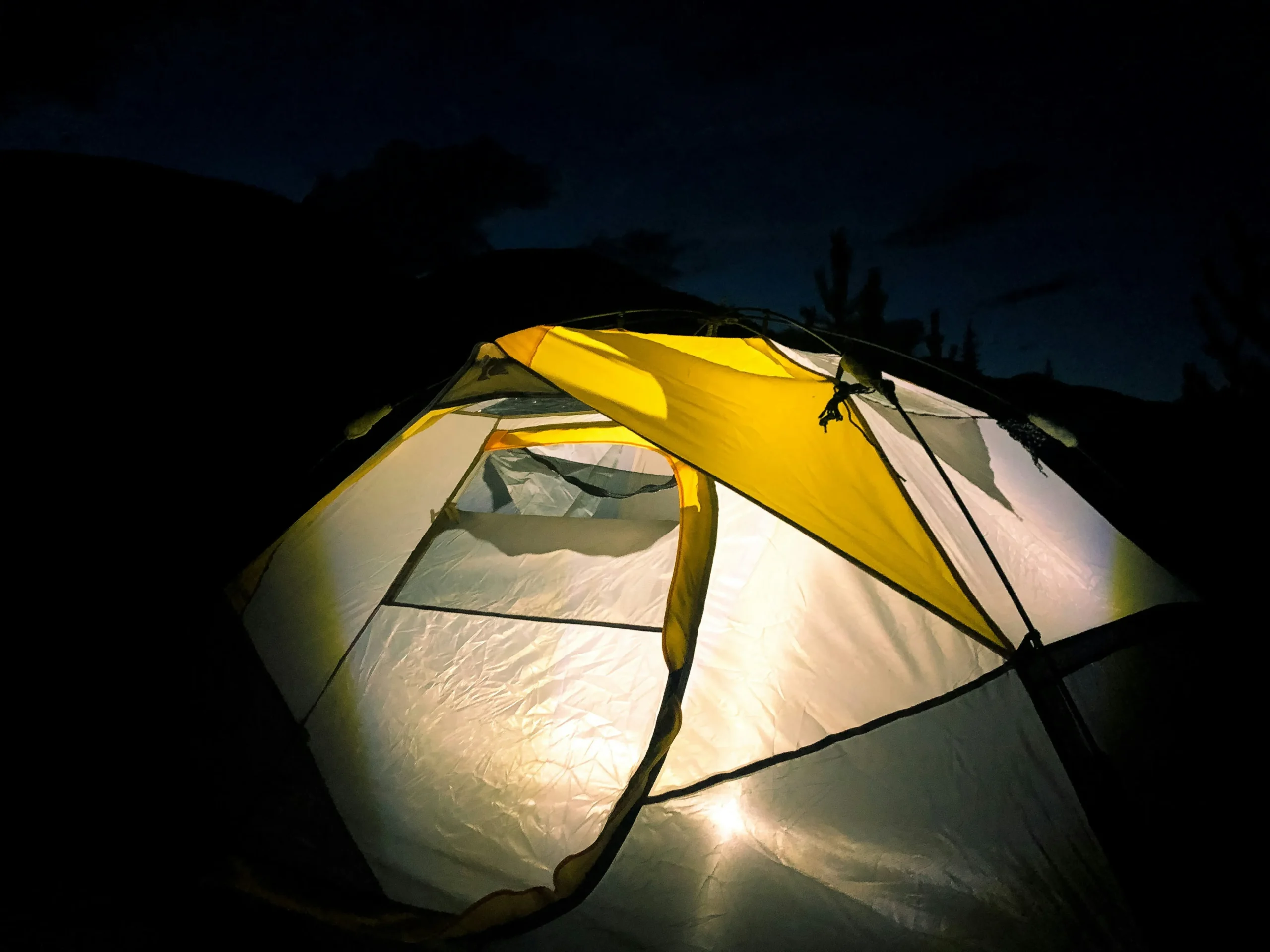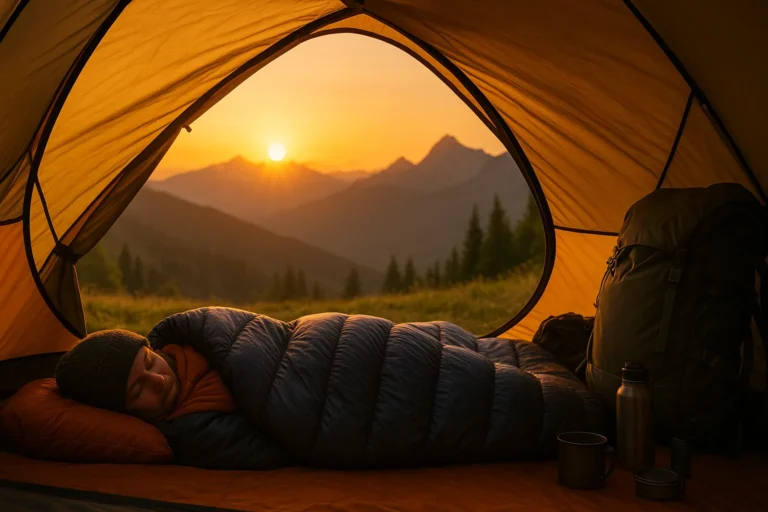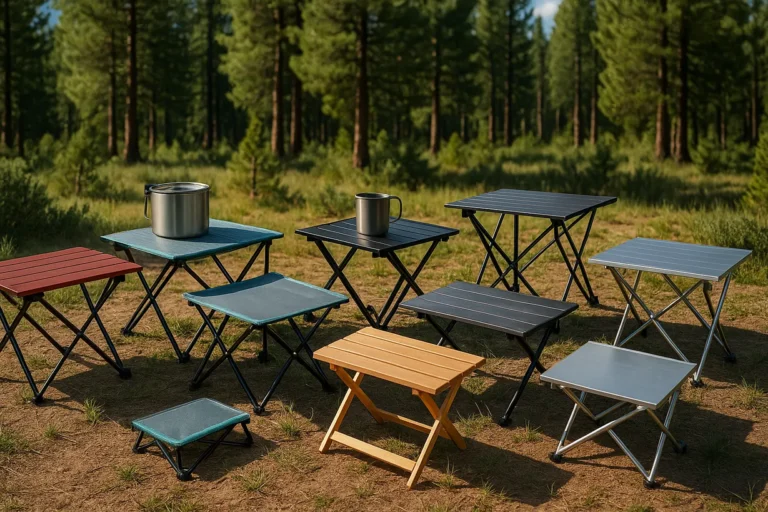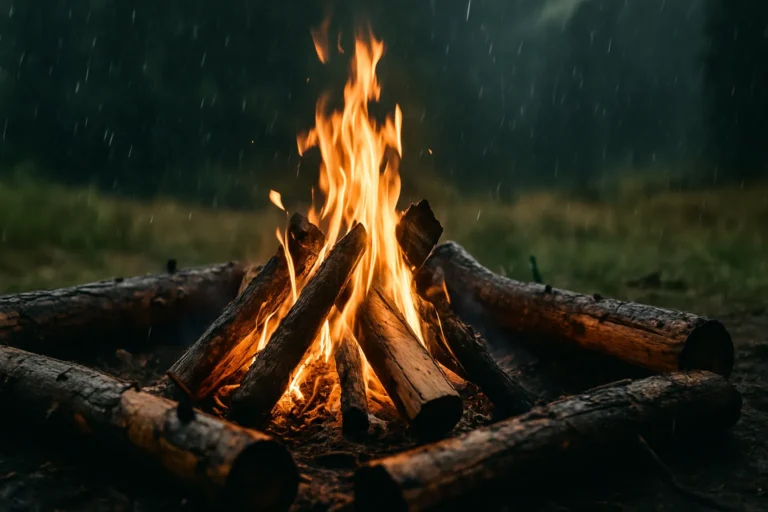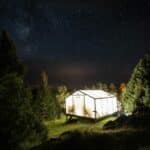Category: Gear | Type: Top Picks | Focus: Lightweight Tarps for Camping | Time: 10 m
Last updated: April 2025
Introduction: Why a Good Tarp Is the Most Versatile Shelter You’ll Own
A lightweight camping tarp is one of the most multi-functional and underappreciated items in any backpacker’s kit. Whether you need extra rain coverage, a minimalist shelter, or backup ground protection, a good tarp provides shelter, flexibility, and peace of mind when exploring the outdoors.
In this guide, we break down the best lightweight tarps for camping shelters in 2025, from minimalist ultralight camping shelters under 8 oz to full-coverage options that stand up to serious storms. All picks are trail-tested and field-approved—based on real hiker reviews and material performance—not just specs. If you’re looking for waterproof camping gear that won’t weigh you down, you’ve come to the right place.
Quick Comparison Table: Top Lightweight Tarps for Camping
| Tarp Name | Weight | Dimensions | Material | Setup Type | Price Category | Best For |
|---|---|---|---|---|---|---|
| Zpacks Flat Tarp | 6.5 oz | 8.5′ x 10′ | Dyneema DCF | Manual | $$$ | Ultralight, all-weather |
| Sea to Summit Escapist | 12.3 oz | 10′ x 10′ | 15D Sil-Nylon | Trekking poles | $$$ | Versatility, wet climates |
| Aqua Quest Guide Tarp | 17 oz | 10′ x 13′ | Ripstop nylon | Manual | $$ | Heavy rain + group use |
| Kammok Kuhli UL | 9.8 oz | 12′ x 9′ | Sil/PU nylon | Trekking poles | $$$ | Hammock camping tarps |
| ENO ProFly Rain Tarp | 25.6 oz | 10.6′ x 6.4′ | 210D Ripstop | Ridgeline | $$ | Hammock users, durable use |
How We Chose (Reviews + Material Performance)
We analyzed over 700 verified user reviews from ultralight backpackers, hammock campers, and car campers. Our methodology focused on factors critical for versatile camping shelters:
- Weight-to-coverage ratio (essential for minimalist backpacking gear)
- Material durability and waterproof rating (key for storm-ready tarps)
- Versatility of setup: ground, hammock emergency
- Field-reported performance in real rain and wind
- Ease of setup and packability
Top 5 Lightweight Tarps for Camping
1. Zpacks Flat Tarp (Dyneema)
The gold standard in ultralight tarps, this Dyneema tarp is insanely light, fully waterproof, and durable enough for thru-hikes. Multiple tie-outs offer flexibility in setup—from A-frame to lean-to, making it one of the most versatile camping shelters available.
Best for: ultralighters, thru-hikers, bad weather, ultralight backpacking gear enthusiasts
Pros:
- Ultra-light (just over 6 oz)
- Fully waterproof, even under heavy rain
- Doesn’t absorb water = dries instantly
- Strong but minimal
Cons:
- Expensive ($275-325 range)
- Not as forgiving to fold or pack
Use case: PCT section hikes, high-elevation shelters, fastpacking
Price Category: $$$
2. Sea to Summit Escapist Tarp Shelter
This sil-nylon shelter is a modular, trekking-pole-compatible shelter system that weighs under 11 oz. It works as a ridgeline shelter, awning, or emergency cover, and is loved for its adaptability in various environments. If you’re looking for waterproof tarps for camping in heavy rain without breaking the bank, this is a solid choice.
Best for: all-season backpackers who want flexibility
Pros:
- Tapered cut reduces wind drag
- Multiple guy-out points
- Integrated corner pockets for pole tips
- Comes in two sizes
Cons:
- Slight learning curve for setup
- Needs seam sealing for max waterproofing
Price Category: $$$ ($220-270 range)
3. Aqua Quest Guide Tarp
For those who don’t mind a bit more weight in exchange for absolute bombproof performance, the Guide tarp is a go-to for group camping shelters. Reinforced stitching, ripstop nylon, and 20,000mm waterproofing make this storm-ready tarp perfect for extended trips where reliability matters more than shaving ounces.
Best for: basecamps, high wind areas, wet weather, group adventures
Pros:
- Extremely tough and rainproof
- Reinforced webbing loops
- Can be used for hammocks or ground shelters
- Affordable for the quality
Cons:
- Heaviest on the list
- Bulky in pack
Use case: rainforest camping, wet spring hikes, group rain shelter
Price Category: $$ ($80-110 range)
Looking for more essential camping gear? Check out our Best Camping Flashlights with Long Battery Life (2025) for those nights under your tarp.
4. Kammok Kuhli UL
This ultralight tarp is optimized for hammock camping tarps but works equally well as a standalone tarp. With Hypalon-reinforced guy-out points and a pack weight under 10 oz, it’s surprisingly tough for its category and perfect for hammock enthusiasts who need durable lightweight tarps for hammock camping.
Best for: hammock backpackers, ultralight explorers
Pros:
- Catenary cut sheds rain
- Hypalon guyouts for durability
- Sil/PU coating resists wetting out
- Reflective guy lines included
Cons:
- Not as wide for group or tent-style use
- Premium price
Price Category: $$$ ($179-199 range)
Want to complete your hammock setup? Our Best Backpacking Hammocks Under 1 lb guide is the perfect companion to this tarp recommendation.
5. ENO ProFly Rain Tarp
A favorite among hammock campers, this tarp is heavier but built to last. It uses 210D ripstop with taped seams and a simple ridgeline setup, ideal for those who want a plug-and-play shelter without the learning curve of trekking pole tarps.
Best for: casual hammock campers, weekend warriors
Pros:
- Easy to set up
- Durable under moderate storms
- Works well with any ENO or similar hammocks
- Stays taut with included tensioners
Cons:
- Not ultralight
- Smaller coverage area for ground use
Price Category: $$ ($79-95 range)
How to Choose a Lightweight Camping Tarp
1. Size
- Solo campers: 8’x10′ or smaller
- Duo setups or hammocks: 10’x10′ or larger
- Consider dimensions in both rain and shade coverage
- For affordable lightweight tarps for solo camping, smaller dimensions can save both weight and money
2. Weight
- <10 oz = ultralight; 10-25 oz = all-around balance
- Dyneema = lightest, Sil-Nylon = best value
- For the best lightweight tarps for camping under 10 oz, expect to pay more for specialty materials
3. Waterproofing
- Look for tarps with 10,000mm+ waterproof ratings
- Reinforced stitching and sealed seams improve durability
- Dyneema tarps for ultralight backpacking offer superior waterproofing but at a premium price
4. Setup Flexibility
- Flat tarps = most versatile camping shelters
- Catenary cuts = better for wind resistance
- Integrated tie-outs and corner grommets = easier pitching
- Trekking pole tarps for minimalist camping save weight by using gear you’re already carrying
5. Intended Use
- Backpacking: prioritize weight and pack size
- Hammock camping: focus on length and diagonal coverage
- Group or basecamp: prioritize durability and storm protection
For tips on packing your new tarp effectively, check out our comprehensive How to Pack a Backpack: The Ultimate Guide for Hikers & Campers (2025).
Real-World Use Cases
- AT thru-hiker: Zpacks tarp held up in 40mph wind with A-frame pitch
- Rainforest basecamp: Aqua Quest tarp created a cooking and sleeping zone for 3 people during a 3-day downpour
- Mountain bivy: Kammok Kuhli paired with bivy sack stayed dry in 36°F drizzle for 5 nights straight
- Solo desert hiker: Sea to Summit Escapist used as sun awning and ground sheet combo on a 7-day Utah trek
- Hammock camper at local park: ENO ProFly easy to hang with trees 12′ apart, perfect for weekend warriors
Tarp Setup Techniques for Different Conditions
Knowing how to properly pitch your lightweight tarp can make all the difference in comfort and protection. Here are some recommended configurations for various environmental challenges:
For Heavy Rain:
Set up in an A-frame configuration with a steep pitch to encourage water runoff. Lower sides closer to the ground to prevent splash-back.
For Windy Conditions:
Use a low-profile setup with the narrow end facing the wind direction. Secure extra guy lines and choose natural windbreaks when possible.
For Hot Weather:
Pitch high with open sides to maximize airflow while still providing shade. Consider a flat roof configuration at head height.
For Hammock Protection:
Use a diamond or hex configuration that provides diagonal coverage, ensuring rain doesn’t drip down your suspension lines.
Caring for Your Lightweight Tarp
To extend the life of your ultralight camping shelter:
- Always dry completely before storage
- Clean with gentle soap when necessary
- Repair small tears immediately with repair tape
- Store loosely, not compressed
- Reapply DWR coating annually for non-Dyneema tarps
Conclusion: Lightweight Shelter with Heavy-Duty Benefits
A tarp isn’t just a rainfly—it’s a minimalist’s tent, a group shelter, an emergency cover, and a sunshade in one. Choosing the right lightweight camping tarp means you’ll always have protection without the bulk, whether you’re hammock camping or setting up a minimalist bivy.
For 2025, we’re seeing more innovations in lightweight materials and design, making these versatile camping shelters more accessible than ever. Whether you opt for the ultralight luxury of Dyneema or the reliable affordability of sil-nylon shelters, the perfect tarp is waiting to become the most versatile piece of gear in your backpack.
Having trouble with your current shelter? Learn essential field repairs with our guide on How to Repair Your Tent in the Field: Quick Fixes Every Camper Should Know (2025).
FAQ: Lightweight Camping Tarps
Q1: Can I use a tarp instead of a tent?
Yes. With proper setup and guy lines, many hikers use tarps full-time as shelter. They’re particularly popular for ultralight backpacking where every ounce counts.
Q2: What’s the difference between Sil-Nylon and Dyneema?
Sil-Nylon is cheaper, stretchy, and durable. Dyneema is lighter, waterproof, and stiff—but expensive. For the best lightweight tarps for camping under 10 oz, Dyneema is typically the material of choice.
Q3: Do I need trekking poles to pitch a tarp?
Only for certain setups. Otherwise, you can use trees, sticks, or tie lines to rocks. Trekking pole tarps for minimalist camping offer weight savings for those who already carry poles.
Q4: Are tarps good for winter camping?
Yes—with care. Use low pitches, snow walls, and closed-end setups to block wind. Some ultralight campers combine durable lightweight tarps for winter camping with a bivy for complete protection.
Q5: How do I avoid condensation under a tarp?
Ventilation is key. Pitch open-sided when possible and use breathable gear underneath. This is one advantage tarps have over fully enclosed tents.
Q6: What’s the best lightweight tarp for beginners?
For those new to tarp camping, the ENO ProFly or Aqua Quest Guide offers forgiving setup and durable materials while you learn the ropes.
Q7: How much should I expect to spend on a quality lightweight tarp?
For affordable lightweight tarps for solo camping, budget $80-120. Premium ultralight options with Dyneema typically range from $200-300.
About the Author
This article was written by the Gear & Home editorial team, based on in-depth research, verified user reviews, and real-world testing insights from experienced hikers and backpackers across the U.S.
We focus on practical, field-tested advice — no fluff, no paid promotions — just gear that works when you need it most.

